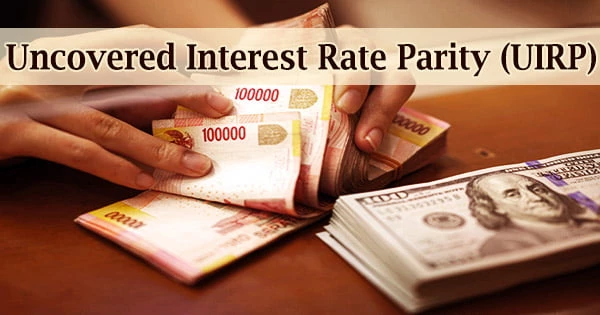According to a financial theory known as the Uncovered Interest Rate Parity (UIRP), the difference in the nominal interest rates of two different countries is equal to the relative changes in the foreign exchange rate over the same time period. It resembles the “Law of One Price (LOOP)” economic theory quite a little.
A no-arbitrage condition known as interest rate parity (IRP) describes an equilibrium state in which investors can take advantage of the interest rates offered on bank deposits in two different countries. The fact that this requirement is not always true creates the possibility of covered interest arbitrage opportunities to generate risk-free gains.
Currency arbitrage, often known as Forex arbitrage, offers a chance to generate risk-free profits if the uncovered interest rate parity relationship is broken. Interest rate parity can take one of two distinct forms: covered interest rate parity or uncovered interest rate parity, which refers to the parity condition in which a forward contract has been used to cover (eliminate exposure to) exchange rate risk. Uncovered interest rate parity refers to the parity condition in which exposure to foreign exchange risk (unanticipated changes in exchange rates) is uninhibited.
It is comparable to UIRP in that both contend that, when currency exchange rates are taken into account, the price of an identical good, financial security, etc. everywhere in the globe should be the same price regardless of where it is in the world. Interest rate parity is said to be uncovered when the no-arbitrage requirement is met without the use of a forward contract to protect against exposure to exchange rate risk.
The fundamental tenet of interest rate parity is that, once interest rates and exchange rates are taken into account, the price of goods should be the same everywhere in a global economy (the law of one price). Risk-neutral investors will be unconcerned about the difference in interest rates between the two nations because there is no chance of uncovered interest arbitrage profits because it is anticipated that the exchange rate between the nations will change so that the dollar return on dollar deposits equals the dollar return on euro deposits.
A lack of excess return from relative changes or disparities in foreign exchange rates is prevented by the uncovered interest rate parity. It does this by making the assumption that the domestic currency value of the nation with the higher interest rate will decline in comparison to the foreign currency value of the nation with the lower interest rate.
The Formula for Uncovered Interest Rate Parity is:
F0 = S0 × 1+ ic / 1 + ib
where:
F0 = Forward rate
S0 = Spot rate
ic = Interest rate in country c
ib = Interest rate in country b
Without interest rate parity, banks and investors would find it relatively simple to profit from disparities in exchange rates. Uncovered interest rate parity contributes to the understanding of how the spot exchange rate is determined.
Another formula for Uncovered Interest Rate Parity (UIRP) is:
espot(t) (1 + iDomestic) = Et[espot(t + k)] ( 1 + iForeign)
Where:
Et[espot(t + k)] is the expected value of the spot exchange rate
espot(t + k), k periods from now. No arbitrage dictates that this must be equal to the forward exchange rate at time t
k is number of periods in the future from time t
espot(t) is the current spot exchange rate
iDomestic is the interest rate in the country/currency under consideration
iForeign is the interest rate in another country/ currency under consideration. The forward exchange rate is the future exchange rate in the equation for the uncovered interest rate parity that was previously described. Banks and foreign exchange dealers both carry them.
In contrast to spot exchange rates, which are current rates, forward exchange rates for currencies are rates for a future point in time. Understanding forward rates is essential for achieving interest rate parity, particularly in the context of arbitrage (the simultaneous purchase and sale of an asset in order to profit from a difference in the price).
Banks and currency dealers offer forward rates for time frames that range from less than a week to five years and beyond. Forward exchange rates are offered with a bid-ask spread, just as spot exchange rates.
Swap points are the distinctions between the forward and spot rates. A forward premium or forward discount is referred to as the difference between the forward rate and the spot rate, depending on whether it is positive or negative.
In comparison to a currency with a higher interest rate, a currency with a lower interest rate will trade at a forward premium. For instance, the U.S. dollar often trades at a forward premium compared to the Canadian dollar, whereas the reverse is true for the Canadian dollar.
Assumptions of UIRP –
- Capital mobility in the market: The uncovered interest rate parity assumes perfect capital mobility in the market.
- Non-arbitrage condition: In the UIRP equation, there is a no-arbitrage requirement. A risk-free return is possible and a chance to achieve a risk-free profit arises if the condition is broken.
Limitations of UIRP –
- Expected rate of depreciation: The predicted rate of depreciation, which is a key factor in uncovered interest rate parity, is frequently less than the discrepancy that has to be corrected, according to empirical research. The efficient operation of the uncovered interest rate parity equation is frequently hampered by such a restriction.
Uncovered interest rate parity conditions have two return streams: one from the change in the foreign currency spot rate and one from the foreign money market interest rate on the investment. The expected return of a domestic asset, such as a risk-free rate like a U.S. Treasury Bill or T-Bill, will be equal to the expected return of a foreign asset after accounting for changes in foreign currency exchange spot rates, or put another way, uncovered interest rate parity assumes foreign exchange equilibrium.
According to UIRP, a depositor holding dollars will receive the interest rate available on dollars, while a depositor holding euros will receive the interest rate available in the eurozone as well as the possibility of a gain or loss on euros depending on the rate of appreciation or depreciation of the euro relative to the dollar.
There can never be an excess return from simultaneously holding a higher-yielding currency investment and shorting a different, lower-yielding currency investment or interest rate spread when uncovered interest rate parity is maintained. According to UIRP, the nation with the higher interest rate or risk-free money market yield will see a decline in the value of its own currency in relation to the foreign one.
From these presumptions, economists have drawn a useful approximation of uncovered interest rate parity. UIRP is related to the so-called “law of one price,” which is an economic theory that asserts that, when currency exchange rates are taken into account and trade restrictions are absent, the price of identical security, commodity, or product traded anywhere in the world should be the same price regardless of location.
The uncovered interest for parity, on the other hand, corrects the disparity in interest rates by matching it to the anticipated rate of depreciation of the native currency. It’s because investors do not gain from any forward cover under an uncovered interest rate parity scenario.
Any excess return on euro deposits must be offset by some anticipated loss from the euro’s devaluation against the dollar assuming uncovered interest rate parity persists and an investor is unconcerned about euro or dollar deposits. The level of the higher-yielding currency’s depreciation over the short and medium-term time horizons is less than the effects of an uncovered interest rate parity, according to empirical research.
















